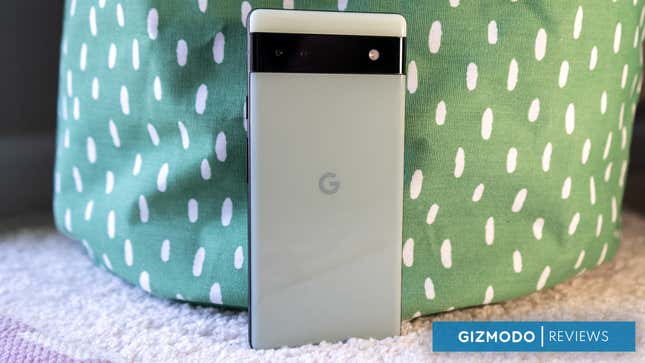
Among Android fans, the Pixel A-series has been a relative hit for Google. Whenever I step into Android spaces, I hear nothing but praise for the company’s mid-range smartphone. I know several “extremely tech-y” people in my life who have lived with the A-series for years, perfectly satisfied with what’s in their hand, enough that they didn’t feel compelled to spend the extra $200 or more for the flagship Pixel. It’s not far off to think the Pixel 6a, available for pre-order today, will continue the legacy.
The Pixel 6a offers all the best parts of a Google flagship without the price tag. It has a stylish, two-toned glass back and Material You-style interface trimmings everywhere, from the Home screen to the Settings panel. It offers immediate access to the Google Assistant, and since it’s a Pixel device, it’ll receive timely software updates directly from Android headquarters. The Pixel 6a is also the first version of the A-series to feature Google’s Tensor chip in a sub-$500 body. This homemade chip facilitates many of the Pixel 6a’s flagship-level capabilities and is ultimately why you might choose this mid-level smartphone over the other similarly-priced devices.
The smallest Pixel you can buy

I was not a fan of the Pixel 6 Pro’s design. Sure, it was big, but the rest of its chassis was too thin and slippery to wield daily. Fortunately, the Pixel 6a takes after the Pro’s smaller sibling, the Pixel 6, so much that the two phones look like they came off the same manufacturing belt. Unfortunately, that doesn’t make the Pixel 6a any less slippery. As I typed out this paragraph, the Pixel 6a almost slipped off me and onto the floor.
The Pixel 6a is the smallest Pixel device you can buy. It’s about .2 inches smaller than the regular Pixel 6 and lighter by nearly 30 grams. The camera bar on the back of the 6a doesn’t stick out as much as on the Pixel 6 flagships.
The Pixel 6a comes in three colorways: Chalk, Charcoal, and Sage. Google sent us the latter for review, and it looks like a pretty seafoam green in person. I wouldn’t mind if Google (and Samsung and everyone else) tossed out black and white entirely and stuck only to color. It looks charming when paired with the matching silicon case from Google.
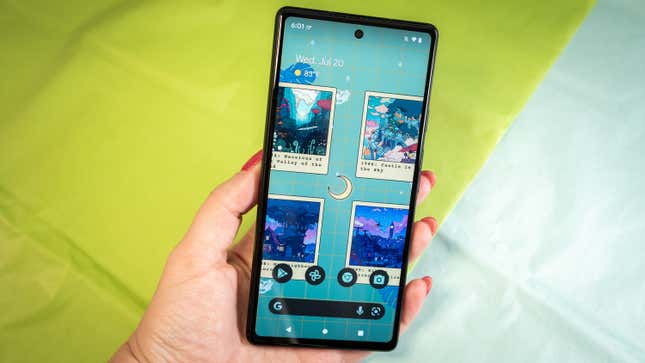
The Pixel 6a has a 6.1-inch FullHD+ display with a 20:9 aspect ratio, though its 60Hz refresh rate feels like it limits it. It’s a good reminder of the concessions you’re making at this price point. In the Pixel 6a’s case, you’re giving up a faster refresh rate in exchange for Google smarts. Other mid-range Android devices, like the Samsung Galaxy A53 5G, offer a 6.5-inch Super AMOLED display with a 120Hz refresh rate, which makes for smoother scrolling and animations. There is some noticeable choppiness when cruising through bloated web links on the Pixel 6a.
At least the Pixel 6a’s screen can get quite bright. Google advertises a “high brightness” mode on the Pixel 6a, which pops up if you turn on adaptive brightness. This can be especially helpful when you’re out in direct sunlight. Otherwise, the display has a maximum brightness of around 515 nits. I also like the additional dimming mode, which comes in handy if you’re like me and fall asleep to TV in the dark.
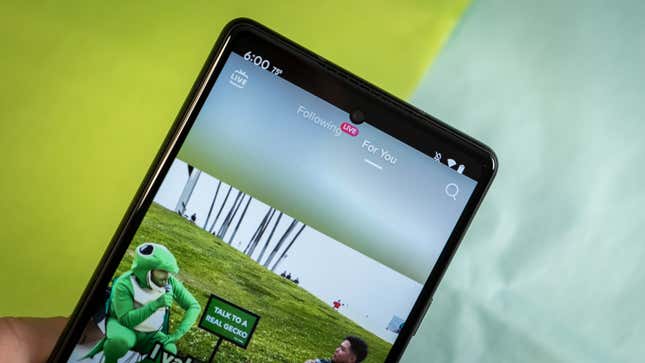
I’m not sure how to feel about the freckle of a front-facing camera staring at me any time I go full screen in an app. It wasn’t always an issue, but I was often reminded of it randomly, like while deep in the TikTok matrix. I prefer the camera off to the side of the display rather than smack dab in the middle.
Yes, the fingerprint unlock is fast
Before it was available for pre-order, the Pixel 6a was heavily teased to have a “fast” in-display fingerprint scanner. It might sound like an odd boast, but that’s because the Pixel 6/6 Pro had disappointing fingerprint unlock, enough that hardware VP, Rick Osterloh, was asked if there would be a different sensor shipping with the Pixel 6a.
I wouldn’t say the fingerprint unlocks perfectly every time. I had to scan my thumb a few different ways to get it initially registered, which didn’t feel like the case when I was setting up, for instance, the Nothing Phone (1), which also uses an in-display fingerprint unlock. But after configuration, it was fast to pass the Lock screen and much quicker than typing in a PIN or sliding out a pattern. It also didn’t feel like I had to place my hand on the screen as steadily as on the Pixel 6 Pro.
Homemade Tensor Chip
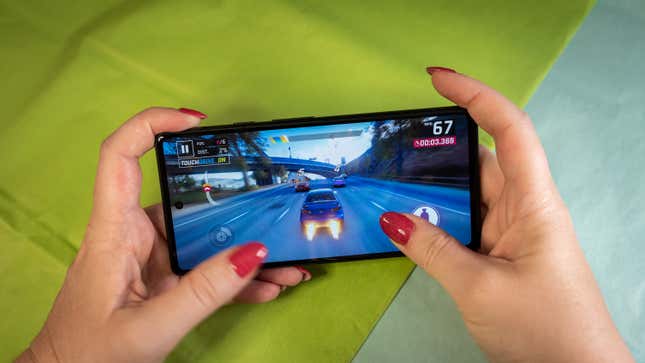
The Google Pixel 6a is billed as a mid-range smartphone, though the chip inside is the same Google Tensor Chip that powers up the Pixel 6. It’s a strategy similar to Apple’s iPhone SE, which uses the same A15 Bionic processor as its iPhone 13 family. This year’s Pixel 6a is also the first of Google’s affordable A-series to use a homegrown chip, versus last year’s Pixel 5a, which utilized Qualcomm silicon.
Our internal benchmarks indicate that going in-house paid off for the Pixel 6a. We don’t have numbers from last year’s release because Geekbench wasn’t compatible with the pre-release hardware we had in hand. So this year, I sideloaded the Geekbench 5 APK to get some raw numbers out of the processor and see where it lands on the Big Board of Benchmark Numbers.
The Pixel 6a scored within the range of the smaller Pixel 6 in the single-core numbers, though multi-core numbers trailed behind a tiny bit. That’s partly due to the Pixel 6a having only 6GB of RAM versus the 8GB in the Pixel 6 and 12GB in the Pixel 6 Pro. Competing mid-range devices, including the Galaxy A53 5G and OnePlus Nord N20, also have the same amount of RAM, so it’s not out of the norm. In the overall Geekbench numbers, the Pixel 6a outperformed the Galaxy A53’s Samsung-made Exynos 1280 processor.
Outside of benchmarks, the Pixel 6a held its own with everyday tasks like editing video clips in InShot, posting confessionals to TikTok, chatting with my buddies in Discord, and taking AR photos of my Galarian Ponyta in Pokémon Go. I also played a few rounds of Asphalt 9 and Sonic CD with the first-generation Razer Kishi strapped on to get a feel for how the device functions as a gaming companion, and it managed fine. But it’s worth noting that this is still a brand new phone that I’ve only been using for a week. The 6GB of RAM means you’ll likely see some stuttering once the going gets tough. The chassis also gets considerably warm when the GPU is in use.
Battery Life is Strong
The Google Pixel 6a has a 4400 mAh battery inside. It’s smaller than the Galaxy A53 5G’s and the battery on last year’s Pixel 5a. Still, Google promises you’ll get plenty of life out of it, with up to 72 hours of battery life on Extreme Battery Saver mode.
I couldn’t test that particular claim since I didn’t have enough time between getting my review unit and publishing this review, and I don’t have an extra SIM to test how the Extreme Battery Saver mode cuts down on things like network pinging. But the Pixeal 6a performed phenomenally in our usual battery rundown test, which involves looping a 24-hour YouTube video on repeat until the device peters out. The Pixel 6a lasted nearly 18 hours, only an hour less than the Pixel 6 with a smaller 4614 mAh battery. The Galaxy A53 outlasted it by half an hour with its 5000 mAh battery.
When you need to charge the battery, the Pixel 6a is capable of adaptive charging, so that it powers up steadily overnight. However, it does not have wireless charging and only supports up to 18W wired charging. It’s also worth noting that no adapter is included in the box, so be sure to secure your own!
Cameras are still the best
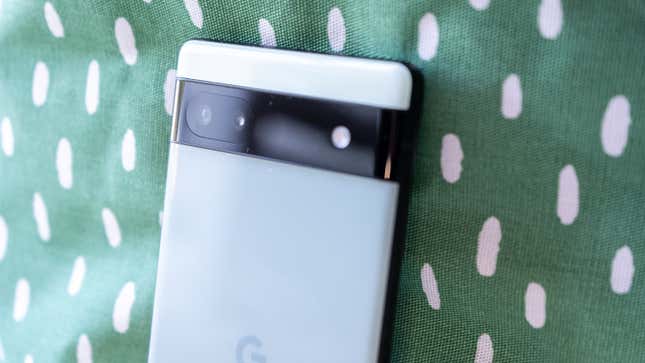
The Pixel 6a is bundled with dual rear-facing cameras, including a 12.2-MP dual pixel wide-angle camera with a 77-degree field of view (FoV), an f/1.7 aperture, and a 12-MP ultrawide camera with a 114-degree FoV and an f/2.2 aperture. The first camera can also super zoom up to 7x, while the second camera provides lens correction. Both cameras have OIS. There’s also a front-facing camera that’s an 8-MP sensor with fixed focus, an 84-degree wide FoV, and an f/2.0 aperture.

The camera performance of the Pixel A-series hasn’t changed much from last year’s Pixel 5a. That is to say, you can still expect flagship-like photo taking at a mid-range price. It remains the best smartphone at this price point for taking long exposure nighttime shots of the sky. I remain impressed at the Pixel 6a’s capture abilities in real world scenarios, especially late at night when I’m chasing my kid around the house as she refuses to sleep. You do start to see the disparities between Pixels at this hour, though.

It’s clear that while the Pixel 6a can do computational processing like the Pixel 6, it’s limited by its lenses. The Pixel 6 Pro, which I used to compare how Google tunes its hardware, takes slightly brighter shots at night because its camera hardware can physically absorb more detail. The Pixel 6a often couldn’t keep up and struggled to shoot moving objects in the dim evening light. My toddler came out blurry-faced in photos. I also noticed that the Pixel 6a tends to overexpose white spaces while the Pixel 6 Pro is more true to life.
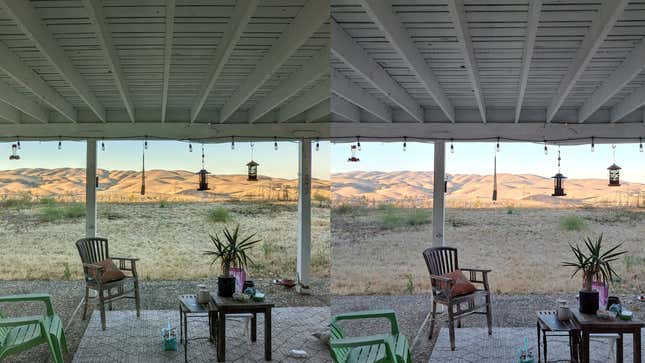
I compared some Pixel 6a shots to the Samsung Galaxy A53, the other marquee mid-ranger. Samsung’s final product is still much more saturated than what Google produces, and sometimes it would blow out the scene instead of upping the detail. But the Galaxy A53 was also able to tap into the focus area of a shot much quicker than the 6a.
If you think you’ll need to rely on zoom, the Pixel 6a might fall short. Its super zoom capabilities are able but aren’t as clear as what the Galaxy A53 can achieve with the aid of its 3x optical zoom. At least the Pixel 6a can zoom in quickly if you’re taking a video, but it’s not the sharpest when you reach the 7x cap.
Pure Google Android

The Nexus days of the Android smartphone are over, so it would be unfair to label the Pixel 6a’s version of the software as “stock.” Instead, it’s Android 12 with a little more of Google’s flavoring, including full commitment to the Material You design paradigm. Google even included an Android 13 beta feature in the build: the ability to turn on matching icons. It looks nice if you have the apps to support it.
As with all Pixel smartphones, the Pixel 6a’s primary focus is getting you onboarded into the Google experience, if you’re not already. It’ll walk you through all the ways you can talk to the Assistant and command it to do your bidding. It’ll also try to push Android’s gesture navigation system on you, which you can thankfully turn off directly from the setup screen. Using a Pixel also nets you access to some exclusive Google Photos features, like Magic Eraser and Face Unblur.
The biggest upside to using a Pixel device is that it’s always going to be in the first push of whatever software update go out to Android. Google promises five years of Pixel updates on this phone, which include security updates and various Pixel feature drops.
There are always concessions
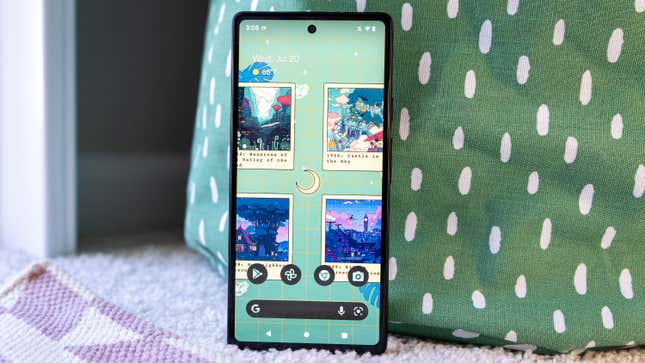
There are still a few caveats to consider if you’re looking to save cash on your next Pixel device. The Pixel 6a is limited to 128GB of storage, which isn’t enough if you’re a meme fiend and you love to take photos and videos of your kid, pets, plants, whatever. Conversely, the Galaxy A53 5G has a microSD slot embedded into the SIM tray, so there’s a chance for storage expansion with another similarly priced phone. The Pixel 6a is also only IPX7 rated, which means it can survive a drop in the toilet but not a long, luxurious bath in the tub.
Then again, maybe you don’t care about that stuff, and all you want is a decent Android phone that won’t break the bank. That’s the Google Pixel 6a. It may not have all the bells and whistles—or the screen refresh rate—of other phones, but it does have all the basics for $450.
This review was updated to include battery results for the Pixel 6a.

